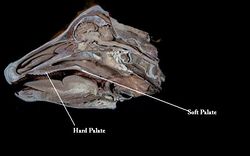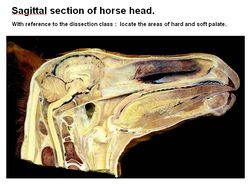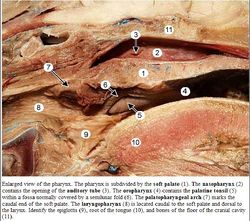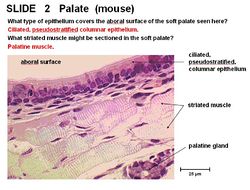Difference between revisions of "Soft Palate"
| Line 1: | Line 1: | ||
==Introduction== | ==Introduction== | ||
| − | The soft palate (velum palatine) is located caudally to the [[Hard Palate|hard palate]] | + | The soft palate (velum palatine) is located caudally to the [[Hard Palate|hard palate]] and is composed of muscle. It is involved in tasting food and in [[deglutition]]. |
| − | [[Image:Hard and Soft Palate Anatomy.jpg|thumb|right|250px|Soft Palate - Copyright Nottingham 2008]] | + | [[Image:Hard and Soft Palate Anatomy.jpg|thumb|right|250px|Soft Palate - Copyright University of Nottingham 2008]] |
==Structure and Function== | ==Structure and Function== | ||
| − | The soft palate is made of | + | The soft palate is made of striated palatine muscle and has very folded mucosa. It contacts the [[Epiglottis|epiglottis]] caudally. |
[[Image:Soft Palate XS.jpg|thumb|right|250px|Soft Palate Cross-section - Copyright RVC]] | [[Image:Soft Palate XS.jpg|thumb|right|250px|Soft Palate Cross-section - Copyright RVC]] | ||
==Musculature and Innervation== | ==Musculature and Innervation== | ||
| − | The soft palate | + | The soft palate transmits sensation and taste via the glossopharyngeal ([[Cranial Nerves - Anatomy & Physiology|CN IX]]) nerve. |
===Palatine muscle=== | ===Palatine muscle=== | ||
| Line 17: | Line 17: | ||
===Tensor velli palatini muscle=== | ===Tensor velli palatini muscle=== | ||
| − | The origin of the tensor velli palatini muscle is near the tympanic bulla on the[[Skull and Facial Muscles - Anatomy & Physiology#Temporal Bone (os temporale)|temporal bone]]. The insertion site is the lateral aponeurosis. It tenses the soft palate. | + | The origin of the tensor velli palatini muscle is near the tympanic bulla on the [[Skull and Facial Muscles - Anatomy & Physiology#Temporal Bone (os temporale)|temporal bone]]. The insertion site is the lateral aponeurosis. It tenses the soft palate. |
[[Image:Pharynx Anatomy.jpg|thumb|right|250px|Soft palate - Copyright C.Clarkson and T.F.Fletcher University of Minnesota]] | [[Image:Pharynx Anatomy.jpg|thumb|right|250px|Soft palate - Copyright C.Clarkson and T.F.Fletcher University of Minnesota]] | ||
===Levator velli palatini muscle=== | ===Levator velli palatini muscle=== | ||
| − | The origin of the levator velli palatini muscle is near the tympanic bulla on the | + | The origin of the levator velli palatini muscle is near the tympanic bulla on the temporal bone. The insertion site is the lateral aponeurosis. It raises the soft palate and recieves major innervation from the vagus nerve ([[Cranial Nerves - Anatomy & Physiology|CN X]]) and minor from the glossopgaryngeal nerve ([[Cranial Nerves - Anatomy & Physiology|CN IX]]). |
===Palatopharyngeus muscle=== | ===Palatopharyngeus muscle=== | ||
| Line 36: | Line 36: | ||
===Equine=== | ===Equine=== | ||
| − | The tight laryngeal cuff around the laryngeal entrance, and therefore the soft palate cannot be raised for long periods of time and thus horses are nasal breathers. Laryngeal cuffing prevents [[ | + | The tight laryngeal cuff around the laryngeal entrance, and therefore the soft palate cannot be raised for long periods of time and thus horses are nasal breathers. Laryngeal cuffing prevents [[Vomiting|vomiting]]. |
===Canine=== | ===Canine=== | ||
| Line 52: | Line 52: | ||
[[Category:Oral Cavity - Anatomy & Physiology]] | [[Category:Oral Cavity - Anatomy & Physiology]] | ||
| − | [[Category: | + | [[Category:A&P Done]] |
Revision as of 23:23, 30 December 2010
Introduction
The soft palate (velum palatine) is located caudally to the hard palate and is composed of muscle. It is involved in tasting food and in deglutition.
Structure and Function
The soft palate is made of striated palatine muscle and has very folded mucosa. It contacts the epiglottis caudally.
Musculature and Innervation
The soft palate transmits sensation and taste via the glossopharyngeal (CN IX) nerve.
Palatine muscle
The origin of the palatine muscle is the hard palate transeverse ridges and the insertion site is the soft palate. The muscle shortens the palate and recieves major innervation from the vagus nerve (CN X) and minor innervation from the glossopgaryngeal nerve (CN IX).
Tensor velli palatini muscle
The origin of the tensor velli palatini muscle is near the tympanic bulla on the temporal bone. The insertion site is the lateral aponeurosis. It tenses the soft palate.
Levator velli palatini muscle
The origin of the levator velli palatini muscle is near the tympanic bulla on the temporal bone. The insertion site is the lateral aponeurosis. It raises the soft palate and recieves major innervation from the vagus nerve (CN X) and minor from the glossopgaryngeal nerve (CN IX).
Palatopharyngeus muscle
The palatopharyngeus muscle closes the palatopharyngeal arch, and therefore lifts the soft palate. It recieves major innervation from the vagus nerve (CN X) and minor innervation from the glossopgaryngeal nerve (CN IX).
Histology
The soft palate contains respiratory mucosa - ciliated pseudostratified columnar epithelium on the aboral surface. There is stratified squamous epithelium on the oral surface. The soft palate also contains palatine salivary glands.
Species Differences
Porcine
The soft palate does not contact the epiglottis as the porcine soft palate is raised higher in the oral cavity than in other species.
Equine
The tight laryngeal cuff around the laryngeal entrance, and therefore the soft palate cannot be raised for long periods of time and thus horses are nasal breathers. Laryngeal cuffing prevents vomiting.
Canine
As brachiocephalic breeds have a shortened skull length, the soft palate can often obstruct air flow into the larynx causing breathing difficulties.
Avian
Birds lack a soft palate.
Links
Click here for the soft palate flashcards.
Click here for the facial muscle flashcards.



